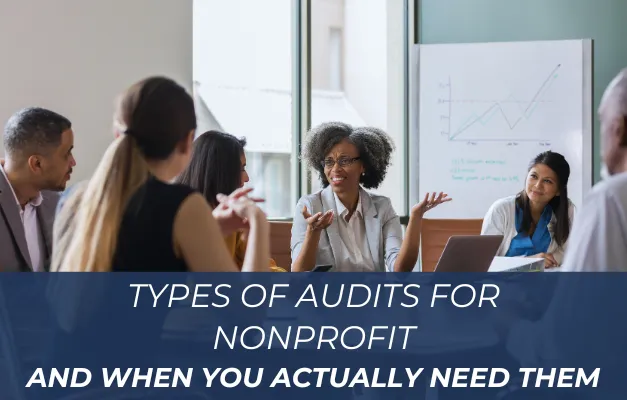Blog
Helping Businesses and Nonprofits Thrive Through Smarter Accounting

Types of Audits for Nonprofits and When You Actually Need Them
Running a nonprofit comes with a unique set of challenges, especially when it comes to financial accountability. Donors, boards, and regulators want transparency, but what does that actually mean in terms of audits?
Here’s a detailed breakdown of the main types of audits a nonprofit might face (or choose), and when each one is necessary.
1. Financial Statement Audit
What It Is:
An independent CPA reviews and expresses an opinion on your financial statements' accuracy, ensuring they comply with generally accepted accounting principles (GAAP).
When It’s Needed:
Required by law in some states based on revenue thresholds.
Often required by major donors, foundations, or government funders.
Best practice for organizations with over ~$500K in annual revenue or growing complexity.
Why It Matters:
This is the gold standard for financial transparency. It gives boards, funders, and the public confidence in how you manage money.
What to Expect:
A detailed review of your financial statements, including balance sheets, income statements, and cash flow.
Interviews with management and testing of financial records.
A final audit report with the auditor’s opinion.

2. Single Audit (Uniform Guidance Audit)
What It Is:
A specialized audit required when your nonprofit spends $750,000 or more in federal funds in a fiscal year. It includes both a financial audit and a review of your compliance with federal grant rules.
When It’s Needed:
Automatically required if you spend $750,000 or more in federal funds.
Even if you only receive pass-through funds (from state/local governments), you may still be subject.
Why It Matters:
Failing to comply can result in grant clawbacks, reputational harm, or funding ineligibility.
What to Expect:
Financial review focused on federal funds.
A compliance test to ensure you are following federal rules.
Reporting to federal oversight bodies.
3. Program or Grant-Specific Audit
What It Is:
An audit focused on a particular program, grant, or restricted fund to ensure it’s being managed and reported properly.
When It’s Needed:
Required by some grantors (especially private foundations).
Helpful when dealing with complex or high-dollar programs.
Why It Matters:
It provides funders with assurance that their money is being used exactly as intended.
What to Expect:
Verification of spending against the grant agreement.
Checks on program outcomes and performance metrics.
4. Internal/Operational Audit
What It Is:
A review of internal controls, policies, and operational practices, usually done by an internal team or outsourced consultant, not just financial.
When It’s Needed:
When scaling up operations.
After leadership turnover.
If fraud risks or inefficiencies are suspected.
As a proactive governance move.
Why It Matters:
It helps you catch weaknesses in processes before they lead to bigger issues.
What to Expect:
Assessment of financial controls, policies, and procedures.
Recommendations for improving efficiency and reducing risks.
5. Agreed-Upon Procedures (AUP) Engagement
What It Is:
Not a full audit, but a customized review of specific items—like expense reports, grant compliance, or fund transfers—based on what the nonprofit and auditor agree to.
When It’s Needed:
If you want assurance on something specific without a full audit.
For internal board requests or specific donor concerns.
Why It Matters:
It’s a flexible, cost-effective way to get targeted insights.
What to Expect:
Specific procedures based on your request (e.g., testing a few transactions, reviewing specific reports).
A brief report with findings, but no full audit opinion.

So… Do You Need an Audit?
Not every nonprofit needs a full audit every year. But many will need some form of assurance, especially as they grow or start handling larger grants.
Questions to Ask Yourself:
Are we hitting any state or federal thresholds?
Are funders asking for one?
Is the board requesting more oversight?
Have we grown quickly or changed key staff?
Something to Think About
Getting ahead of audit expectations now can save you major headaches (and credibility loss) later. Even if it’s not legally required, an audit or review can be a strong signal of transparency and good governance.
Need Help?
We help organizations assess risk, stay compliant, and prepare for audits without getting buried in complexity. Let’s make sure your audit process supports your mission, not distracts from it.
Copyright 2022 - RNB Capital LLC - All Rights Reserved

